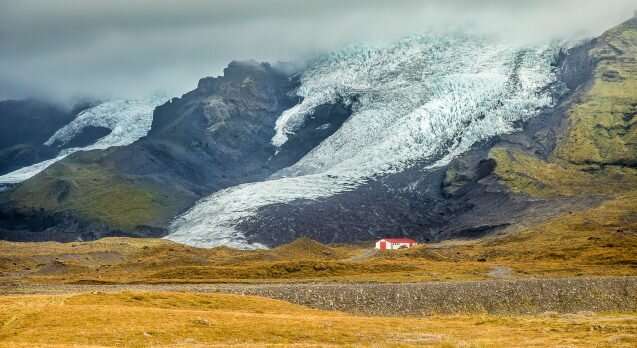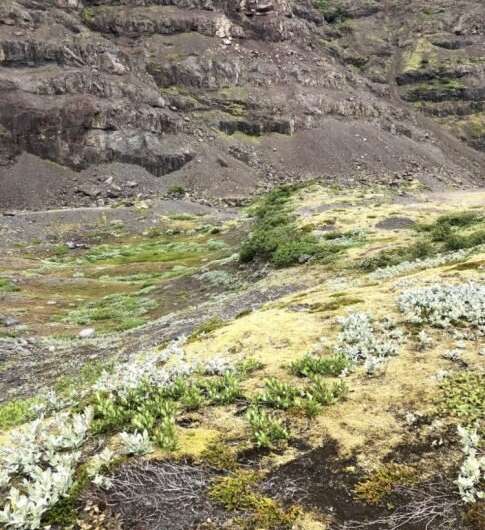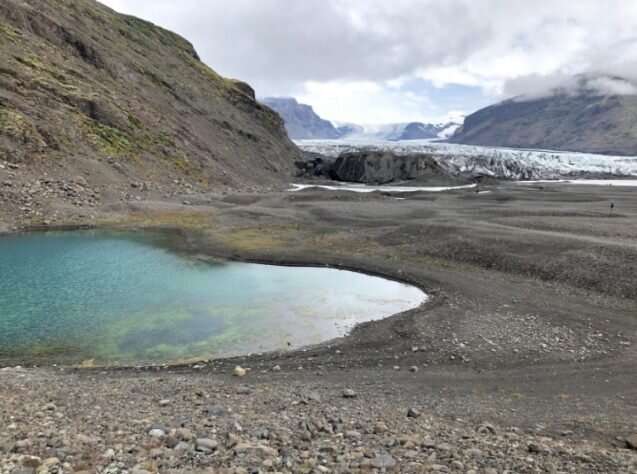A lone house sits at the base of Eyjafjallajökull, one of Iceland’s 269 glaciers. Credit: Vincent Moschetti
As the climate warms and glaciers retreat, the landscape around them is transforming. With the recession of ice, areas that were formerly frozen over can now sustain plant life. A new paper published by scientists from Syracuse, New York's Le Moyne College in Ecological Processes reveals the dynamics of emerging plant growth on the foreland of a retreating glacier in southern Iceland.
Iceland is iconic for its vistas of icy expanses. However, as global temperatures rise, its wintry image is rapidly being remade. Since 2000, Iceland has lost 750 square kilometers of glacier—an area more than four times the size of the District of Columbia. Glacier loss has been a concern for many Icelanders, as illustrated by a funeral held for the country's former Ok glacier in 2019.
The Skaftafells glacier, the main focus of the study, in southern Iceland is no exception to these trends. This glacier has been retreating since the end of the Little Ice Age in the late 19th century. Its retreat has accelerated in the present centuries. As the glacier melts, it exposes land that has been under ice for centuries. This bare land gives ecologists a unique opportunity to observe how a plant community establishes itself in a formerly glaciated area.
In many areas of Iceland, it is tricky to study plant growth, as animals like reindeer and sheep graze new plants as soon as they pop up. "We have not studied other forelands due to the impact of sheep grazing," said Mikael-Ann Melfi, one of the paper's authors, in an interview with GlacierHub. "The national park excluded sheep from Skaftafell long ago, making it the perfect location for our study."
Mosses, downy birch and wooly willow cover an area recently exposed by the retreat of Skaftafellsjӧkull. Credit: Haley Synan
When a plant community establishes or reestablishes itself in an area that was previously bare, the plants colonize in stages, a process ecologists refer to as succession. "Moss is one of the earlier succession plants, specifically Racomitrium canescens, or hoary fringe moss," said Haley Synan, another of the paper's authors, in an interview with Glacierhub. "Other earlier successional plants are grasses and willows."
The foreland of the receding glaciers is strewn with moraines, piles of rock and sediment that the glaciers leave behind as they retreat. Areas of the foreland that have been exposed for longer have reached later stages of succession and show a different species composition. As the edge of the glacier continues to move up the mountain, a gradient of successional stages emerges. In addition to the enduring mosses that cover the ground throughout all succession stages, the land further downslope can sustain later succession species like birch trees, and areas more recently exposed are home to willows and small shrubs.
The weather conditions in Iceland—low temperatures and strong winds—prevent full grown forests from forming there: the birches and willows remain as small shrubs rather than towering trees. Despite their small size, their presence will change the ecosystem, and they may prove an important tool for storing carbon dioxide as glaciers melt.
As plants photosynthesize, they take in carbon dioxide and release oxygen. Woody plants like trees and shrubs store the carbon they intake in their leaves, stems and roots. Moss, too, sequesters carbon. The natural increase in plant life on the sites exposed by melting glaciers may serve to help mitigate the released carbon that caused the melting.
Green life begins to take over on the foreland of Skaftafellsjӧkull. Credit: Haley Synan
This mediating effect could be particularly important as the earth underneath glaciers is revealed. "Once the glacier pulls back, the exposed soil would be subject to erosion and if there is ancient organic matter this could be decomposed, releasing carbon dioxide to the atmosphere," said Kevin Griffin, an ecologist and professor at Columbia University's Department of Earth and Environmental Studies, in an interview with GlacierHub. "This essentially converts a neutral landscape (ice covered) to a carbon source."
The problems associated with glacier melt don't stop at carbon release. Glaciers have very high albedo, a measure of how much light bounces back from a surface. Snow and ice reflect a high percentage of sunlight back into the atmosphere and darker colored surfaces reflect back very little, absorbing the energy instead. Just as a paved road becomes baking hot under the beating sun, darker surfaces absorb more energy from the sun. On a global scale, lower albedo means a warmer planet.
Though plant life is an excellent carbon sink, ground covered in plants rather than ice has a significantly lower albedo. Still, the rapid emergence of vegetation on these sites is a hopeful sign. "While it would be preferable for the ice to remain," said Griffin. "If the ice is going to melt, the establishment of these [plant] systems is the best possible outcome and having it proceed quickly is similarly important."
More information: Haley E. Synan et al. Spatial and temporal dynamics of growth of woody plant species (birch and willows) on the foreland of a retreating glacier in southern Iceland, Ecological Processes (2021). DOI: 10.1186/s13717-021-00282-9
Provided by Earth Institute at Columbia University
This story is republished courtesy of Earth Institute, Columbia University http://blogs.ei.columbia.edu.


























